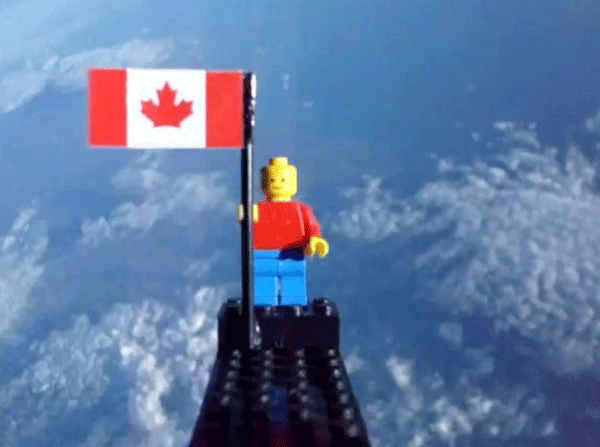
Two young makers from Toronto, Mathew Ho and Asad Muhammad, both age 17, successfully sent a Lego minifig and four cameras to roughly 78,000 feet elevation on a homemade weather balloon. After a 97-minute flight, the balloon returned to Earth with great footage of the journey.
Inspired by a similar project done by MIT students, they were determined to make everything from scratch, down to sewing the 5-foot-diameter parachute. After about five months worth of weekends devoted to the build, they did it, and have some great photos to show for their hard work. Check out the video posted on the Toronto Star to hear them talk about their project and to see their balloon pics.
[Thanks Rachel!]
26 thoughts on “Toronto Teens Send Lego Minifig to Space”
Comments are closed.
ADVERTISEMENT
Join Make: Community Today










I am guessing that helium was used, though i might be wrong about that. However if so, It has occured to me that more altitude might be achieved if hydrogen was substituted. It is little flamible perhaps on an oxygen atmosphere but who cares once it is at high altitude where ther is little or none.
Roy Maybery
[…] And now we find that a couple of Lego Maniacs (remember those commercials?) have sent a Lego minifig into space. […]
What would happen if this went through an aircraft’s engine?
Depends on what kind of aircraft. A propeller would just shred it and fly on, but a turbine might suffer some serious damage. That’s why the FAA and other aviation regulators require high-altitude balloon launchers to get clearance first, so they can issue a warning to air traffic in the area. If someone got proper clearance and conducted the launch as scheduled, but a plane flew into the balloon anyway, liability would be on the pilot.
[…] En thestar.com, vía Make. […]
[…] [make] Submitted by: UnknownIncorrect source or offensive? […]
[…] Toronto teens send Lego man on an a balloon odyssey 24 kilometres high (via Make) […]
[…] Toronto Teens Send Lego Minifig toSpace [MAKE] canadatoyslego Discuss Share Tweet Email More get_count_post('http://www.kotaku.com.au/2012/01/kids-shoot-lego-figure-into-space/','post-487297'); « Previous post […]
[…] TO INFINITY AND BEYOND: This is absolutely the coolest story and video about supremely clever lego-loving Canadian science n… […]
[…] Toronto teens send Lego man on an a balloon odyssey 24 kilometres high (via Make) […]
[…] http://blog.makezine.com/2012/01/25/toronto-teens-send-lego-minifig-to-space/ Share this:TwitterFacebookLike this:LikeBe the first to like this post. Leave a comment […]
[…] we let them spend their own money on space travel programmes, sort of like these guys or these guys or these guys? Problem solved. Share this:EmailFacebookTwitterRedditStumbleUponLike this:LikeBe […]
That’s amazing and really incredible. Super cool stuff!